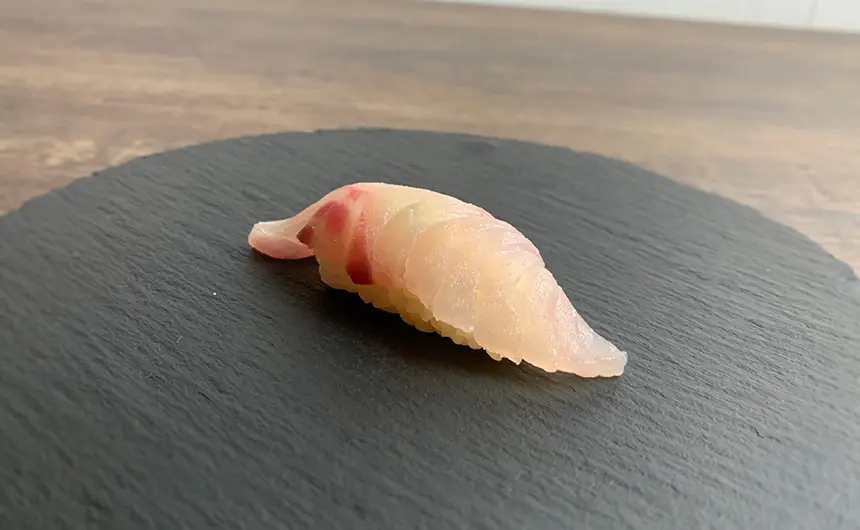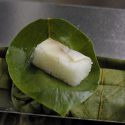こんなにたくさん!寿司のバリエーション紹介 So Many! Introducing Various Sushi
寿司といっても色々な種類があるのをご存知ですか?今回は寿司のバリエーションを詳しくご紹介します。これを知ったら、ますます寿司が好きになるかも!
Did you know that there are different types of sushi? Here are some of the variations of sushi in detail. Seeing their different sides could make you fall in love with sushi all over again.
握り寿司(にぎりずし) Nigirizushi
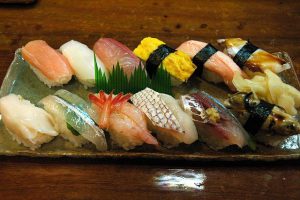
酢飯(すめし)にワサビを塗り魚介類を乗せて握ったもの。もっともポピュラーな寿司です。基本は、旬の魚を中心にした魚介類の切り身が寿司種(すしたね・寿司の具材で、タネ・ネタとも言われる)。江戸時代・文政年間(1818-1830年)に考案されました。この頃はサイズが今の2~4倍と大きく、食事というよりはおやつでした。保存の問題から、酢で締めたり加工していた素材も、製氷機の発展で生で使えるようになり種類も増え、現代の握り寿司へと変化してきました。
This is the most popular kind of sushi. It has seafood on top of vinegar rice usually with wasabi paste. A slice of seasonal seafood is commonly used as sushi-tane (a main ingredient on top of rice, also called tane or neta). Nigirizushi was invented in the Bunsei period of the Edo era (1818 to 1830). Originally, its size was two to four times larger, and it was enjoyed as a snack instead of a meal. The ingredients for sushi in this period were pickled in vinegar and processed for preservation. With the invention of the ice-maker, ingredients became safe to use raw, and evolved into the style of nigirizushi known today.
軍艦巻き(ぐんかんまき) Gunkanmaki
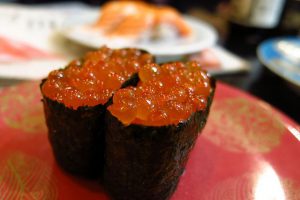
酢飯を海苔(のり)で巻き、その上に寿司種を乗せた寿司。海苔を器に見立て、イクラやウニ、トビコなど、形が崩れやすく握り寿司にしにくいものや、あえ物を盛って提供できることが特徴。1941年に東京・銀座の寿司店「久兵衛」(きゅうべえ)が考案したとされます。現在では、回転寿司店でハンバーグなどが乗っているものもあります。
Gunkanmaki has sushi-tane on top of vinegared rice wrapped in seaweed. By wrapping seaweed around the rice, a bowl-like space is created to hold ingredients that otherwise fall apart easily, like salmon roe, sea urchin, and flying fish roe. It is said that gunkanmaki was established in 1941 by Kyube, a sushi restaurant in Ginza, Tokyo. In recent times we have begun to see some conveyor belt sushi restaurants pop up that offer rare sushi-tane like meatloaf.
巻き寿司(太巻、中巻、細巻) Makizushi (Futomaki, Chumaki, Hosomaki)
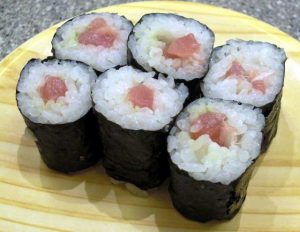
巻き寿司は、江戸時代中期の1750年~1776年の間に生まれ、1783年頃に一般化したと考えられています。海苔に酢飯を広げてその上に具を乗せて、巻き簾(まきす・巻くための道具)で巻いたもので、太さによって「太巻」「中巻」「細巻」とも呼ばれます。太いものほどたくさんの種類の具が入ります。断面に美しく絵柄がでるように巻いた寿司は「飾り巻き寿司」と呼ばれます。
アメリカ西海岸生まれの「カリフォルニアロール」も巻き寿司の一種。日本に逆輸入されたことでも有名です。
Makizushi was first created between 1750 and 1776, in the mid-Edo era, and was popularized by around 1783. It is a rolled sushi made by spreading rice on seaweed, laying ingredients on top, and rolling with a tool called makisu. Types of makizushi are classified differently depending on their thicknesses: futomaki is the biggest, chumaki is medium sized, and hosomaki is the smallest. There are more ingredients contained in the thicker varieties of makizushi. Kazari makizushi is a type of rolled sushi with an illustration on the surface, made by carefully layering the ingredients. The California roll, which was established on the American west coast is also a type of makizushi, and is well-known for having been re-imported to Japan.
手巻き寿司 Temakizushi
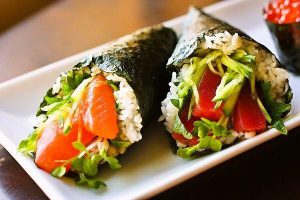
巻き簾を使わず手で巻く寿司は「手巻き寿司」と呼ばれます。家庭でも気軽に食べられています。海苔とさまざまな寿司種と酢飯を用意して、海苔の上に酢飯を置いて、好きな具を乗せ、くるっと巻いて食べます。
Rolled sushi made without makisu is called temakizushi (hand-rolled sushi), and is popular as home-made sushi. If you have prepared the seaweed, various sushi-tane, and vinegared rice, the rest is easy. Simply spread the rice on the seaweed, choose your favorite sushi-tane, and roll it up to enjoy.
稲荷寿司(いなりずし) Inarizushi
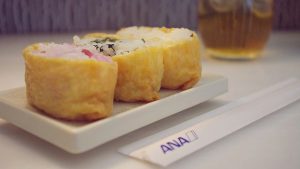
江戸時代(1603年-1868年)末期に考案されたといわれます。「お稲荷(いなり)さん」とも呼ばれます。袋状に開いた油揚げを、醤油や砂糖などで甘くあるいは甘辛く煮付け、酢飯をそのまま、あるいはニンジンやシイタケなどの具材を煮込んで混ぜた酢飯を詰めてできあがり!
Inarizushi was established around the end of the Edo era (1603 – 1868). It is also called oinarisan. This sushi has vinegar rice (sometimes also with carrots and shiitake mushroom) stuffed inside pouch-shaped deep fried tofu that has been broiled in a sweet or spicy-sweet mixture of soy sauce and sugar.
押し寿司 Oshizushi
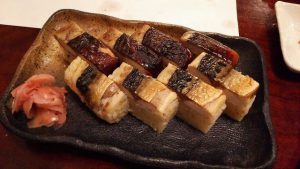
酢飯と具を重ね、型に入れて押した寿司。京都の「鯖(さば)の棒寿司」、富山の「鱒(ます)寿司」などが有名。型で作った後に、切り分けて食べます。保存性が高いので持ち運びに適します。日本では安土桃山時代(1573年-1603年)になると酢が作られるようになり、この頃に押し寿司も登場しました。
This is a type of sushi made by pressing vinegar rice and sushi-tane into a box. Famous oshizushi include saba no bo-zushi (pressed sushi shaped like a mackerel rod) of Kyoto, and masu-zushi (trout sushi) of Toyama. After being shaped in a box, oshizushi is cut into a few pieces. Oshizushi is more easily preserved, so it is suitable as a take-out meal. Vinegar was first produced in the Azuchi-Momoyama period (1573 – 1603) and it is said that oshizushi was established in a similar period.
柿の葉寿司 Kakinohazushi
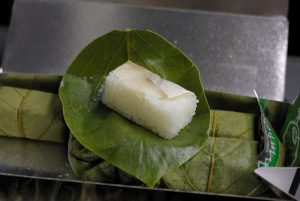
こちらも江戸時代(1603年-1868年)に登場。一口大の酢飯に鯖や鮭などの切り身を合わせ、柿の葉で包んで型で押した押し寿司の派生型。柿の葉は剥がして食べます。柿の葉には殺菌効果があり、包むことにより保存性が高くなります。
Kakinohazushi was first founded in the Edo era (1603 to 1868). This is a bite-size pressed sushi wrapped in a persimmon leaf with mackerel and salmon sushi-tane similar to oshizushi. The persimmon leaf has an antiseptic effect, thus improving the preservative quality. The leaf should be removed before eating.
ちらし寿司 Chirashizushi
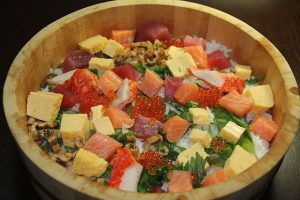
歴史に登場したのは1664年頃。酢飯の上ににぎり寿司に使用する寿司種を「散らす」ため「ちらし寿司」と呼ばれます。寿司種を並べた「生ちらし」や、細かく切った寿司種や生魚をランダムに配置する「ばらちらし」、酢飯に具材を混ぜ込み、その上に錦糸卵(きんしたまご・薄い卵焼きを細く切ったもの)などで飾り付けした「五目ちらし」などがあります。
Chirashizushi was first established circa 1664. Its name comes from the Japanese word ‘chirasu’, which means ‘to sprinkle’, as this sushi has scattered sushi-tane on vinegared rice. There are various types of chirashizushi like nama-chirashi, which has large pieces of seafood arranged nicely, bara-chirashi, which has small cut pieces of sushi-tane scattered on vinegared rice, and gomoku-chirashi, which has vinegared rice mixed with ingredients and egg omelet cut into strings.
なれ寿司(ふな寿司、へしこ、かぶら寿司など)Narezushi (Funazushi, Heshiko, Kaburazushi)
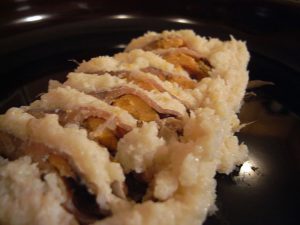
主に魚を塩と米飯で乳酸発酵させた食品です。乳酸発酵により酸味を生じさせるもので、現在の寿司の原型。歴史は古く平安時代(794年-1185年)中期頃からあります。アユやフナ、アワビなどを具材としたものが多く、現在は郷土料理として作られています。江戸時代になると酢が出回るようになり、発酵によらずに酢飯を使用した寿司が作られて、それが主流になりました。
Narezushi is a fish fermented in salt and rice. As this is a lactic acid fermentation, it creates a sour taste. Narezushi is the original form of sushi, and it was established in the mid-Heian era (794 to 1185). Today it is served as local cuisine which uses seafood like trout, gibel, and abalone. As vinegar became more accessible in the Edo era, narezushi became less popular as fermentation was no longer required.
いかがでしたか?寿司と一口に言ってもさまざまな種類があります。ぜひ、いろいろ試してくださいね!
As you can see, there are many types of sushi in Japan. Please try each type and explore for yourself when you have the chance.
※本記事の情報は執筆時または公開時のものであり、最新の情報とは異なる可能性がありますのでご注意ください。
*Please note that the information in this article is from the time of writing or publication and may differ from the latest information.
出典:WOW!Japan

